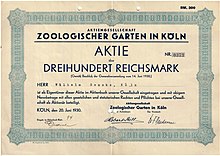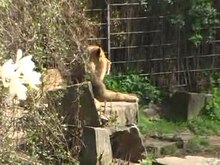Cologne Zoological Garden
 aerial view of Cologne Zoological Garden | |
| Date opened | 1860 |
|---|---|
| Location | Cologne, North Rhine-Westphalia, Germany |
| Coordinates | 50°57′30″N 06°58′24″E / 50.95833°N 6.97333°ECoordinates: 50°57′30″N 06°58′24″E / 50.95833°N 6.97333°E |
| Land area | 20 hectares (49 acres) |
| No. of species | 700+ |
| Memberships | EAZA, WAZA |
| Public transit access | 18 Zoo/Flora |
| Website | www |

The Aktiengesellschaft Cologne Zoological Garden is the zoo of Cologne, Germany. It features over 10,000 animals of more than 850 species on more than 20 hectares. The internationally renowned zoo with an attached aquarium and invertebrate exhibit is active in preservational breeding of animals that are in danger of becoming extinct. In addition, in-the-wild conservation efforts and research focussing on animals of Madagascar, Wallacea, and Vietnam are actively promoted and supported via cooperation with Cologne University and local projects, such as in the case of Przewalski's horses.
The zoo was founded in 1860. The world wars led to a phase of stagnation, and the zoo had to close for two years entirely, after virtually being destroyed in World War II. It reopened in 1947; the aquarium was added in 1971. In 1985, the large primate house, one of the main attractions, was opened. Today, the zoo also features a free-flight rainforest hall with free-ranging birds and reptiles opened in 2000, a large elephant park, a house for hippos with great underwater views, and as the latest addition, a farm with rare native species and petting zoo.
Notable exhibits[]

- Rainforest hall - since 2000
- Asian elephant park
- Hippodom - hall for hippos, crocodiles and aardvarks in the form of a replica of an African river landscape
- farm with rare native cultivated animals and petting zoo for children
- Madagascar House with rare lemurs
- Aquarium with a huge variety of reptiles, fishes and insects
- Great ape section
- Meerkat paddock
Mammals
|
|
|

Birds
|
+ many more smaller birds |
European Endangered Species Programmes[]
Note that not all these species are present/on display at all times. Programmes marked bold are coordinated at Cologne Zoo. Less-endangered species may be kept to train for more endangered relatives.
Birds
|
|
|
Mammals
|
|
|
(Current as of 2005-AUG-01: [1])
Cologne Zoo's engagement for conservation breeding[]
Cologne Zoological Garden is one of the pioneers of international conservation efforts of zoos. Cologne Zoo manages on the one hand a number of projects on its own. On the other hand, the Zoological Garden of Cologne supports partner organisations for other projects with expertise and financial resources. The Zoo combines every new major construction project with a related natural conservation project in situ.
Between 2010 and 2018, Cologne Zoo was able to donate around 1,6 Mio. euro for wildlife conservation with grants for various projects. It also strongly promote wildlife conservation locally in the Rhineland area, cooperating with local organisations.
As a scientific zoo, Cologne Zoo fulfil numerous tasks. On the one hand, it is an attractive location that combines entertainment, fun, relaxation and education. And on the other hand, it is aware of the problems that wildlife face and have therefore become an important global player in nature and wildlife conservation initiatives in recent years. Cologne Zoo effectively coordinates its actions and initiatives through national associations such as the Association of Zoological Gardens (VdZ) and internationally active and networked organisations such as the European Zoo Association (EAZA) and the World Association of Zoos (WAZA).
Cologne Zoo's work focus on breeding endangered species under conditions appropriate to their species. As part of this, it coordinates breeding programmes and maintains breeding registers worldwide for numerous species. Nearly half of the species Cologne Zoo manages this way are listed as “endangered” on the International Union for Conservation of Nature's (IUCN) Red List. The goal is to provide genetically variable and viable wildlife stocks and prepare animals for release into the wild if possible.
The zoo's engagement here has kept species such as the European bison, California condors, bali mynas, Przewalski's horses and sable antelopes from extinction. Cologne Zoo is also active in research and collaborates with the University of Cologne and other research institutions. Much of the knowledge about wildlife comes from research on such animals that are in human care.
Incidents[]
On August 25, 2012, the Siberian Tiger Altai attacked his zookeeper and fatally injured her. The animal had entered through an open security lock into a covered part of his enclosure, which the zookeeper was cleaning. The cat was shot by director Theo Pagel with a rifle to allow rescue workers access to the carer.
Notes[]
External links[]
| Wikimedia Commons has media related to Cologne Zoological Garden. |
- Homepage of Cologne Zoo (in English)
- Video Webcam in the Elephant Park ...watch out for the babies! Marlar (f, born 4-2006) and Ming Jung (m, born 4-2007)
- Cologne Zoo at Zoo-Infos.de (in English)
- Cologne Zoo on zooinstitutes.com
- Zoos in Germany
- Tourist attractions in Cologne
- Buildings and structures in Cologne
- 1860 establishments in Prussia
- Nippes, Cologne
- Zoos established in 1860

